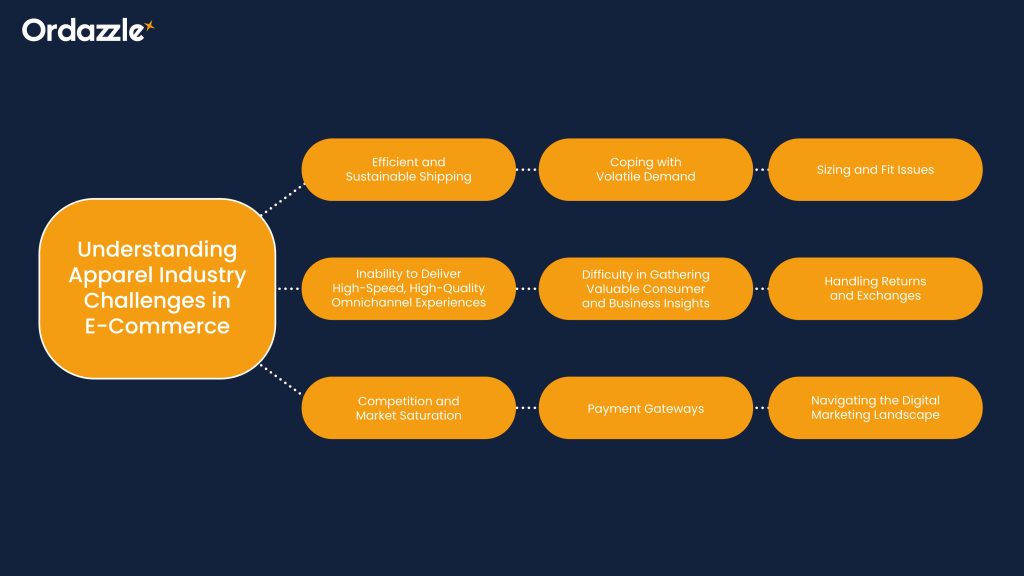
Navigating the Challenges in the E-commerce Apparel Industry
Decades ago, shopping for clothes was a lively, personal experience with visits to bustling markets and chic boutiques. Fast forward to the present, and the landscape has shifted dramatically with shifting to clicks and carts. The apparel industry has changed with the emergence of digital marketplaces and e-commerce.
Today, the apparel sector stands out as a dynamic and challenging frontier, with a projected global market value of US$ 193.7bn by 2027 at a growth rate of 2.76%. This growth, while remarkable, brings with it a myriad of challenges.
In this blog, we explore these challenges and present effective strategies for overcoming them and transforming them into opportunities for growth and innovation.
Understanding Apparel Industry Challenges in E-commerce:
The e-commerce apparel industry faces several unique challenges –
 Challenge 1: Efficient and Sustainable Shipping
Challenge 1: Efficient and Sustainable Shipping
Shipping in online shopping comes with problems. It can be costly, slow, and not great for the environment. Inefficient logistics and reliance on non-renewable resources for transportation exacerbate these issues, highlighting the need for more sustainable practices in the e-commerce industry.
To fix this, stores are getting smarter with how they send things out. They’re planning their deliveries better to save time and money. They’re also using packaging that’s better for the environment. Plus, they’re giving customers different shipping choices to fit their needs. This way, shipping becomes more efficient and green.
Challenge 2: Coping with Volatile Demand
The fashion industry is always evolving, influenced by different seasons, cultures, and consumer taste changes. This makes it quite unpredictable for retailers. Because of such volatility, they face the challenge of overstocking or understocking. It’s a tough balance to maintain in a constantly evolving market.
Managing inventory is key to navigating this unpredictable market. Efficient e-commerce inventory management systems are vital. These systems show stock levels in real-time so retailers can make better decisions. They also use demand forecasting, predicting what customers will buy next. This helps stores keep just the right amount of stock.
Challenge 3: Sizing and Fit Issues
Returns due to sizing errors are a major issue in the apparel industry, leading to increased costs and logistical challenges for businesses. This problem also exacerbates environmental impacts due to additional shipping and packaging waste. Addressing sizing inaccuracies can reduce return rates, save resources, and improve customer satisfaction in the long run.
To combat this, e-commerce stores offer detailed size charts, customer reviews focusing on fit, and innovative solutions like virtual fitting rooms, which use AR technology to help customers visualize how garments will fit. This can help the industry reduce returns and ensure customers are happier with what they buy.
Challenge 4: Inability to Deliver High-speed, High-quality Omnichannel experiences
Combining online and offline shopping is the way ahead to deliver high-speed, high-quality customer experiences because customers often want to try products before buying them online. Managing online and offline sales simultaneously requires an effective setup that ensures consistent service, pricing, and product availability across all channels, whether customers shop online, in-store, or mobile. Advanced technological solutions, such as omnichannel management systems, are essential for integrating these diverse shopping platforms and delivering a unified, smooth customer experience.
Challenge 5: Difficulty in Gathering Valuable Consumer and Business Insights
Finding the top-performing channels and goods requires utilizing real-time data and insights from linked ecosystems. Using this information, you can improve operations and manage seasonality, excessive demand, and other issues.
Unfortunately, obtaining accurate and up-to-date data is challenging when employing a tiered distribution structure and multiple sales channels. Without it, you might have too much or too little stock. You won’t know your best products in different places or which sales tricks are working. Understanding what your customers like can also be tough. A robust, unified e-commerce system is the best solution to gather accurate consumer and business insights and streamline operations. Additionally, it will simplify the order processing process and synchronize orders with inventories.
Challenge 6: Handling Returns and Exchanges
Exchanges and refunds are inseparable components of the online retail sector. Customers might return products due to size mismatches, quality issues, or simply because the item needed to meet their expectations. Implementing a clear return policy, ensuring an easy return process, and maintaining stringent quality control can reduce the rate of returns. Finally, streamline the return process to make it hassle-free, which can improve customer trust and satisfaction.
Challenge 7: Competition and Market Saturation
The e-commerce apparel market is highly competitive, with numerous brands vying for consumer attention. This competition is heightened by the presence of both local and global players, making it tough for new brands to stand out.
Identifying and focusing on a niche audience can also lead to more effective marketing and customer loyalty. Use data analytics to comprehend consumer preferences to modify your products appropriately. Incorporating an omnichannel management system for a better presence and integrating online and offline marketing strategies can amplify your brand’s visibility.
Challenge 8: Payment Gateways
Customers from different regions may prefer different payment methods, and not accommodating these preferences can lead to lost sales.
Provide a range of payment methods to serve a worldwide clientele. This covers popular e-wallets, bank transfers, credit and debit keycards, and, in some circumstances, cash on delivery. Stay updated with the popular payment methods in key markets and integrate them into your platform. Ensure that the payment process is secure, straightforward, and mobile-friendly.
Challenge 9: Navigating the Digital Marketing Landscape
The digital marketing world constantly evolves, making it challenging for the apparel industry to keep up with the competition and algorithm changes. To stay ahead, it’s crucial to embrace data-driven marketing strategies. This involves analyzing consumer behavior, preferences, and trends to make informed decisions and tailor marketing efforts for maximum impact.
Leveraging the power of social media and forming influencer partnerships helps brands connect with their target audience, showcase their products, build brand loyalty, drive traffic, and boost sales.
Conclusion:
Successfully navigating the challenges of the e-commerce apparel business involves a multifaceted approach that includes leveraging technology, enhancing customer experience, committing to sustainability, and differentiating from competitors.
The key to overcoming these obstacles is adopting a sophisticated e-commerce system, like the one offered by Ordazzle, equipped with cutting-edge technologies, which can significantly streamline your e-commerce operations, boost efficiency, and secure a competitive edge in this fast-paced industry.
Reach out to us and explore how our comprehensive technology solutions can transform your e-commerce challenges into opportunities for growth and innovation.




 Challenge 1: Efficient and Sustainable Shipping
Challenge 1: Efficient and Sustainable Shipping